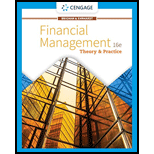
a)
To determine: The definition of agent, principal and agency relationship.
a)
Explanation of Solution
If one or more people, the managers, employ another person, the agent, conduct some service and then assign decision-making authority to that agent, an agency relationship occurs. Relationships between primary agencies exist among
- Stockholders and managers
- Debt holders and stockholders.
b)
To determine: The definition of agency cost.
b)
Explanation of Solution
The expenses of the corporation include all costs incurred by investors to enable management to increase the stock value of a company rather than operating in their interests. The three key types of company costs are"
- Administrative activities controlling expenditure, such as audit costs.
- Expenditure on structuring an organization in such a way as to reduce undesirable managerial behavior, such as nominating outside investors to the board of directors.
- Expenditure on incentives incurred when restrictions imposed by shareholders, such as criteria for voting by shareholders on certain topics, hinder managers ' ability to take appropriate action to improve shareholder wealth.
c)
To determine: The definition of basic types of agency conflicts.
c)
Explanation of Solution
An agency issue arises when a company manager owns less than 100% of the common stock of the company, creating a potential conflict of interest called an agency conflict. The fact that the director will not receive all the wealth benefits generated by his or her efforts or bear all the expense of perquisite consumption would increase the incentive to take actions that are not in the best interests of non-manager investors.
There may also be conflicts between stockholders (through managers) and creditors in addition to conflicts between stockholders and managers. Creditors have a claim for payment of interest and principal on debt on part of the company's earnings stream, and in the event of bankruptcy, they have a claim on the company's assets. Nevertheless, stockholders monitor decisions (through managers) that affect the company's riskiness.
d)
To determine: The definition of managerial entrenchment; nonpecuniary benefits.
d)
Explanation of Solution
Managerial entrenchment occurs when a company has such a weak board of directors and in its corporate charter has such strong anti-takeover provisions that senior managers feel there is very little chance of being removed. Non-specific benefits are non-real cash rewards, such as luxury workplaces, country club memberships, corporate jets, and an excessively large staff.
e)
To determine: The greenmail; poison pills; restricted voting rights.
e)
Explanation of Solution
Targeted share repurchases, also termed as greenmail, occur when a firm buys back stock at a higher than fair market price from a potential acquirer. The potential acquirer agrees, in return, not to try to take over the business. Provisions on investor rights, also known as poison pills, enable existing shareholders in a company to purchase additional stock shares below market value if a prospective acquirer buys a majority stake in the company.
A limited clause of voting rights deprives a shareholder of voting rights automatically if the shareholder owns more than a defined amount of stock.
f)
To determine: The definition of stock options; ESOP.
f)
Explanation of Solution
A stock option permits its owner to buy a stock share at a fixed price, termed the strike price, regardless of what the stock's actual price is. Stock options always have an expiry date after which they cannot be exercised.
A limited stock grant allows an employee to buy stock shares at a large discount from the current stock price, but for a specified number of years, the employee is restricted from selling the stock. An Employee Stock Ownership Plan often referred to as an ESOP, is a type of retirement plan where employees own the company's stock.
Want to see more full solutions like this?
Chapter 13 Solutions
Financial Management: Theory & Practice
- please don't use ai and if you cant understand given values please don't answer question otherwise unhelpful will be given.arrow_forwardfinance subjectarrow_forwardCould you help explain, what is the complete salary survey analysis, and ensuring the data is relevant and up-to-date? What is the job evaluation and compensation plan? How to ensure the final report is comprehensive, clearly structured, and aligned with the company vision?arrow_forward
- The maturity value of an $35,000 non-interest-bearing, simple discount 4%, 120-day note is:arrow_forwardCarl Sonntag wanted to compare what proceeds he would receive with a simple interest note versus a simple discount note. Both had the same terms: $18,905 at 10% for 4 years. Use ordinary interest as needed. Calculate the simple interest note proceeds. Calculate the simple discount note proceeds.arrow_forwardWhat you're solving for Solving for maturity value, discount period, bank discount, and proceeds of a note. What's given in the problem Face value: $55300 Rate of interest: 10% Length of note: 95 days Date of note: August 23rd Date note discounted: September 18th Bank discount rate:9 percentarrow_forward
 EBK CONTEMPORARY FINANCIAL MANAGEMENTFinanceISBN:9781337514835Author:MOYERPublisher:CENGAGE LEARNING - CONSIGNMENTBusiness/Professional Ethics Directors/Executives...AccountingISBN:9781337485913Author:BROOKSPublisher:Cengage
EBK CONTEMPORARY FINANCIAL MANAGEMENTFinanceISBN:9781337514835Author:MOYERPublisher:CENGAGE LEARNING - CONSIGNMENTBusiness/Professional Ethics Directors/Executives...AccountingISBN:9781337485913Author:BROOKSPublisher:Cengage Intermediate Financial Management (MindTap Course...FinanceISBN:9781337395083Author:Eugene F. Brigham, Phillip R. DavesPublisher:Cengage Learning
Intermediate Financial Management (MindTap Course...FinanceISBN:9781337395083Author:Eugene F. Brigham, Phillip R. DavesPublisher:Cengage Learning- Principles of Accounting Volume 2AccountingISBN:9781947172609Author:OpenStaxPublisher:OpenStax College
 Auditing: A Risk Based-Approach to Conducting a Q...AccountingISBN:9781305080577Author:Karla M Johnstone, Audrey A. Gramling, Larry E. RittenbergPublisher:South-Western College Pub
Auditing: A Risk Based-Approach to Conducting a Q...AccountingISBN:9781305080577Author:Karla M Johnstone, Audrey A. Gramling, Larry E. RittenbergPublisher:South-Western College Pub




